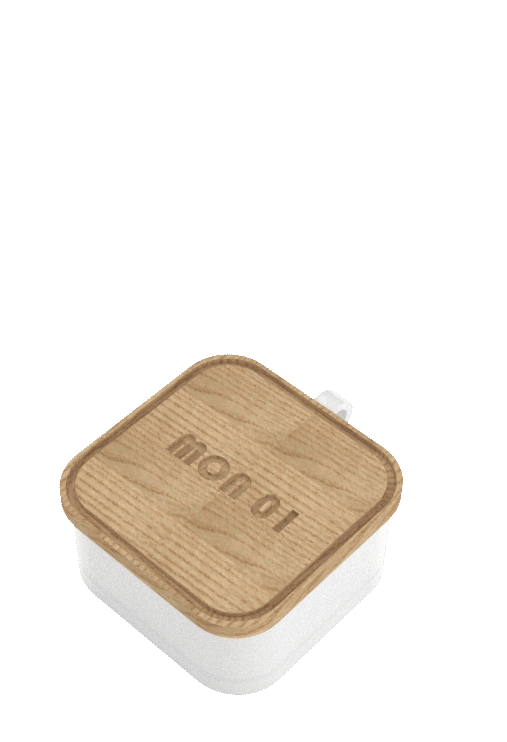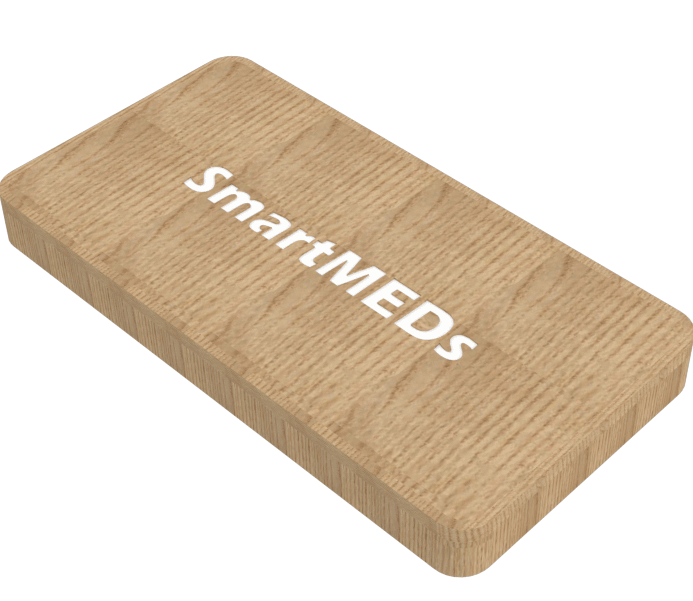SmartMeds

TIME
2022 Fall
TEAMMATES
Chieh-Hsi Lin | Liwen Wu | Ziyan Zhou
MY ROLE
UI/UX Design | 3D Modeling | User Research
TOOLS
Figma | Illustrator | Photoshop | After Effect | Rhino
PROBLEM STATEMENT
How can we help patients and caregivers better manage medication and side effects during recovery?
DESIGN OVERVIEW
SmartMEDs proposed a mobile application and a Bluetooth pillbox for medication management and communication for patients and caregivers. Via the product, users are able to complete three main tasks: 1) Search for medicine information, 2) Set reminder for medication adherence, and 3) Document and sharing patient's health condition.
Background

Have you ever encountered these struggles?
💊
💊
💊
💊
Worrying about your sick parents not taking their medication on time while you're working away from home and unable to care for them for extended periods 😷
Concerned about the communication between your parents and their doctors, and wanting to stay updated on your parents' health status 🩺
Needing a reminder to take your own medication in case you forget during a busy work or school day 💼
Wanting to document and visualize your own recovery progress and share it with important people while battling medical conditions 📝
These struggles are common worldwide. According to the WHO, adherence among chronic disease patients in developed countries averages only 50%. In the United States, only 80% of new prescriptions are filled each year, with just 50% of those filled being taken correctly in terms of 'timing, dosage, frequency, and duration' (Neiman, 2017).
So, how can technology help patients and caregivers better manage medication during recovery?
UX Research
To understand the problem, we conducted six interviews with potential users: three caregivers of patients with chronic diseases and three patients who need to take medication themselves. Each interview lasted approximately 30 minutes and addressed two main questions:
-
What causes the low adherence rate among patients with chronic medical conditions?
-
What difficulties do patients and caregivers face during the recovery process?
By analyzing interviewees' responses via affinity walls, we highlighted four main pain points:
Challenge #1

Forgetting to take or refill medicine
"There were a few times when my grandfather asked me and my sister to buy pills for him at night because we forgot to refill the bottle.”
“I set an alarm every time, so it's much better, but sometimes I still forget”
“My time for lunch is not regular so I cannot set an alarm to remind myself. There were several times that I forgot to take my medication at noon."
Challenge #2

Communication difficulties between caregivers or with doctors
“When the doctor asked me about my grandfather's medicine, I wasn't able to remember everything."
“I have a friend that was cut off from medication by her parents several times when she got better, because they thought she was cured.”
Challenge #3

Unclear information about the medicine and side effects
“My grandfather did complain about the side effects and he was reluctant to take medicine because of that.”
Challenge #4

Taking the wrong medicine
“When I was at my worst, I could not tell what medicine I was taking and could not count how many pills there were.”
“One day my mom accidentally gave the wrong pills to my dad because they had similar packages side by side.”
“I did not pay enough attention to the side effects until my dizziness got very serious and I fell over. I wish I could know in advance and communicate with my doctor sooner to avoid it.”
“It is really common that me and my sister both forgot to give my grandfather his medicines, sometimes we took care of him at different times and didn't communicate well.”
“Being aware of the side effects is very important. I was overdosed on medication due to side effect one time... I needed to be hospitalized and change medication.”
Persona
Primary Persona: Sarah (Care Giver)

Secondary Persona: Adam (Patient)


Design Idea
Brainstorm and Initial Ideas

Alarm Application + Calendar Widget

Smart Pillbox + Digtial Screen

Mobile Application + Augmented Reality
Final Idea

Mobile Application + Physical Pillbox
The final proposal is a mobile application with automatic input, reminders, and a tracker, along with a Bluetooth-enabled pillbox that uses AR visualization to help patients identify the correct pills. This system aims to address one of the problems we discovered in our research: ensuring users take their medication on time, record side effects and symptoms, and share their recovery progress with family and friends.
Storyboard
Use Case 1 - Care Giver

Use Case 2- Patient

User Flow
Low Fidelity Prototype
Paper Prototype

Low Fidelity Prototype


Testing and Iterations
Throughout the process, we conducted one round of Heuristic Evaluation and two rounds of Usability Testing. The participants in the usability testing were potential users who fit the primary and secondary personas of caregivers and patients. The feedback focused on the Home Page, Medicine List Page, and Medicine Info Page.
Home Page Feedback and Iterations

Iteration 1

Iteration 2

Iteration 3

Medicine List Page Feedback and Iterations

Iteration 1

Iteration 2

Iteration 3

Iteration 4

Medicine Info Page Feedback and Iterations

Iteration 1

Iteration 2

Iteration 3

Iteration 4


Design System
Color
UI Element

High Fidelity Prototype
Scan to Add Medicine to Personal List
With one easy scan to get information on side effects and instructions, users no longer need to worry about reading the tiny letters on the information sheet. This feature is especially convenient for elderly users

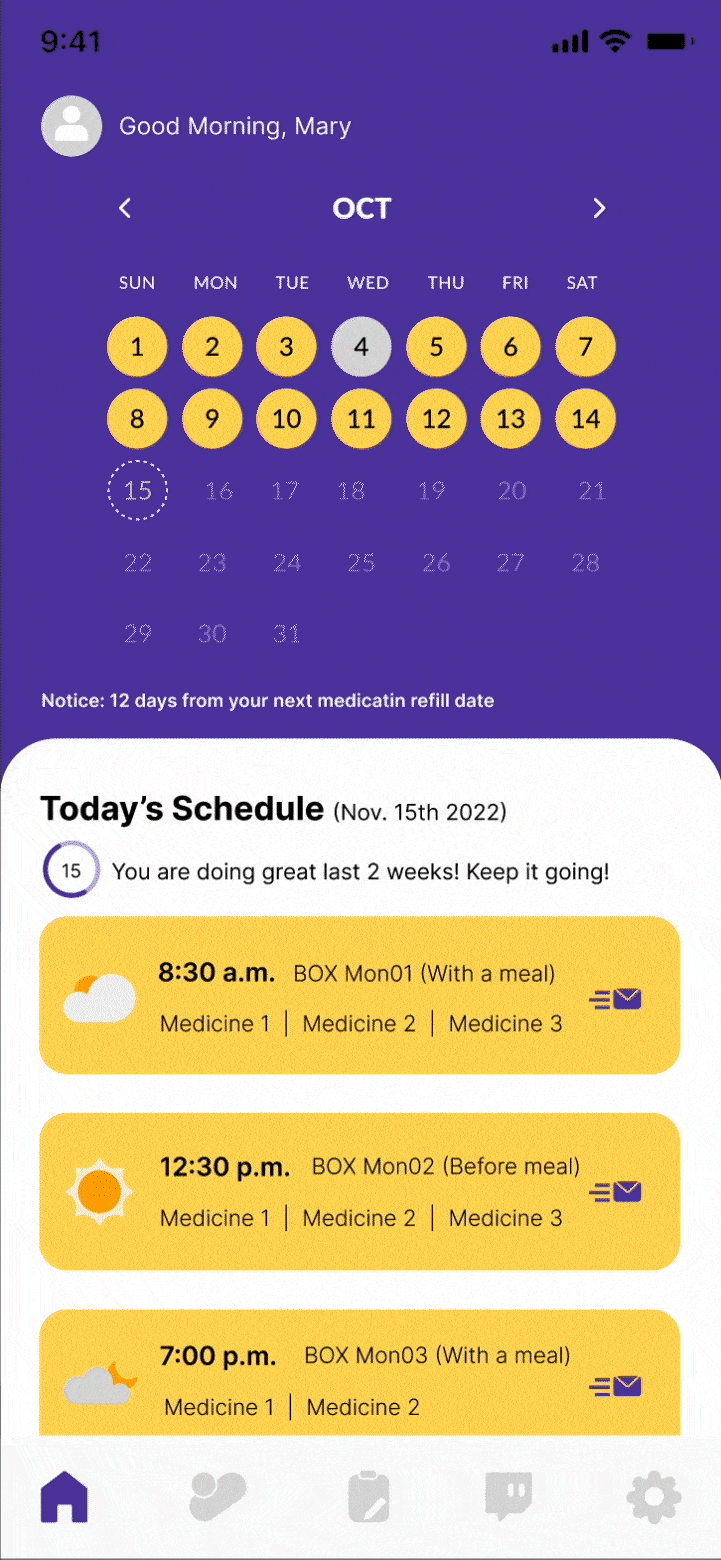
Customized and Thoughtful Reminders
To enhance the user experience, the app offers diverse notification and reminder designs to protect user privacy and avoid habituation.

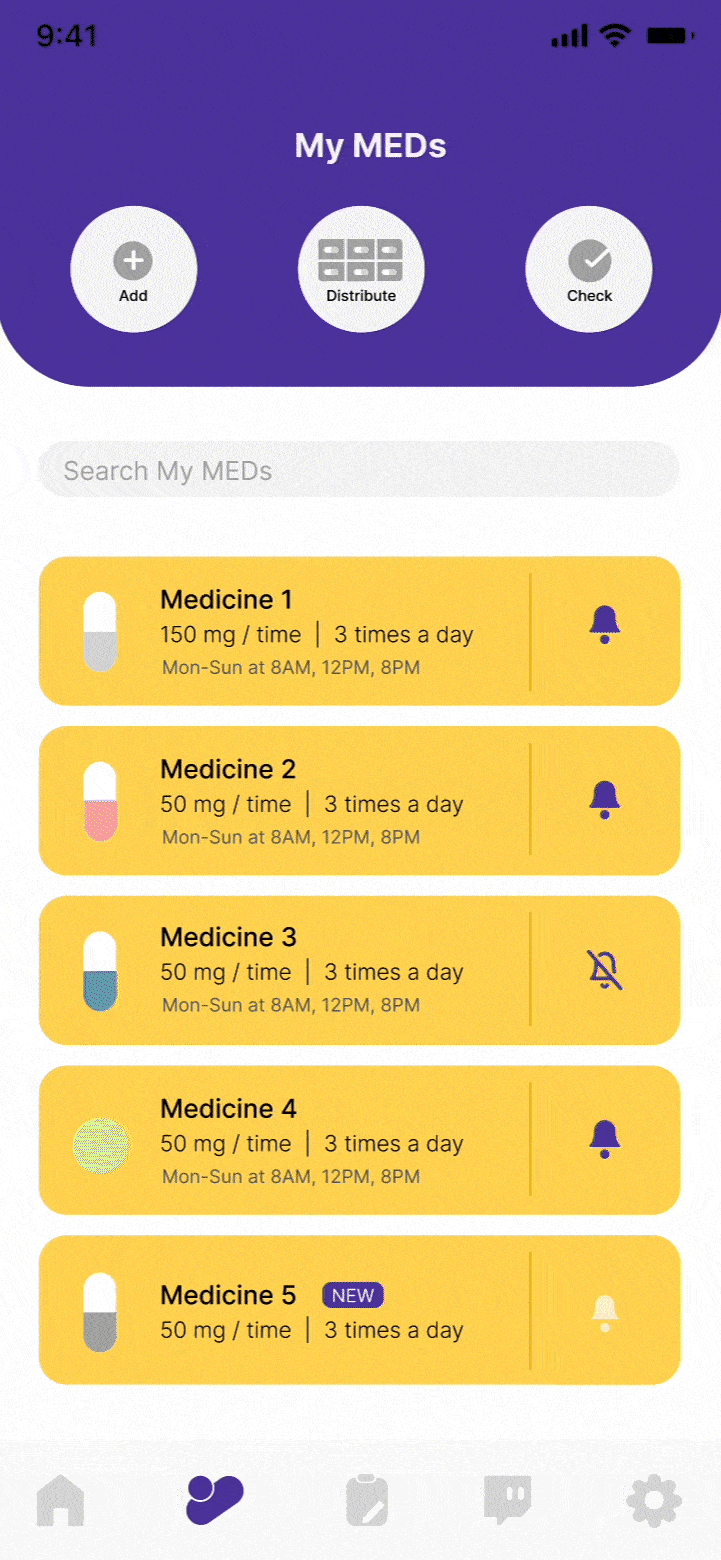
Share Notes and Updates with others
With the note feature, caregivers can document progress and side effects, enabling more effective communication with each other and with the doctor.

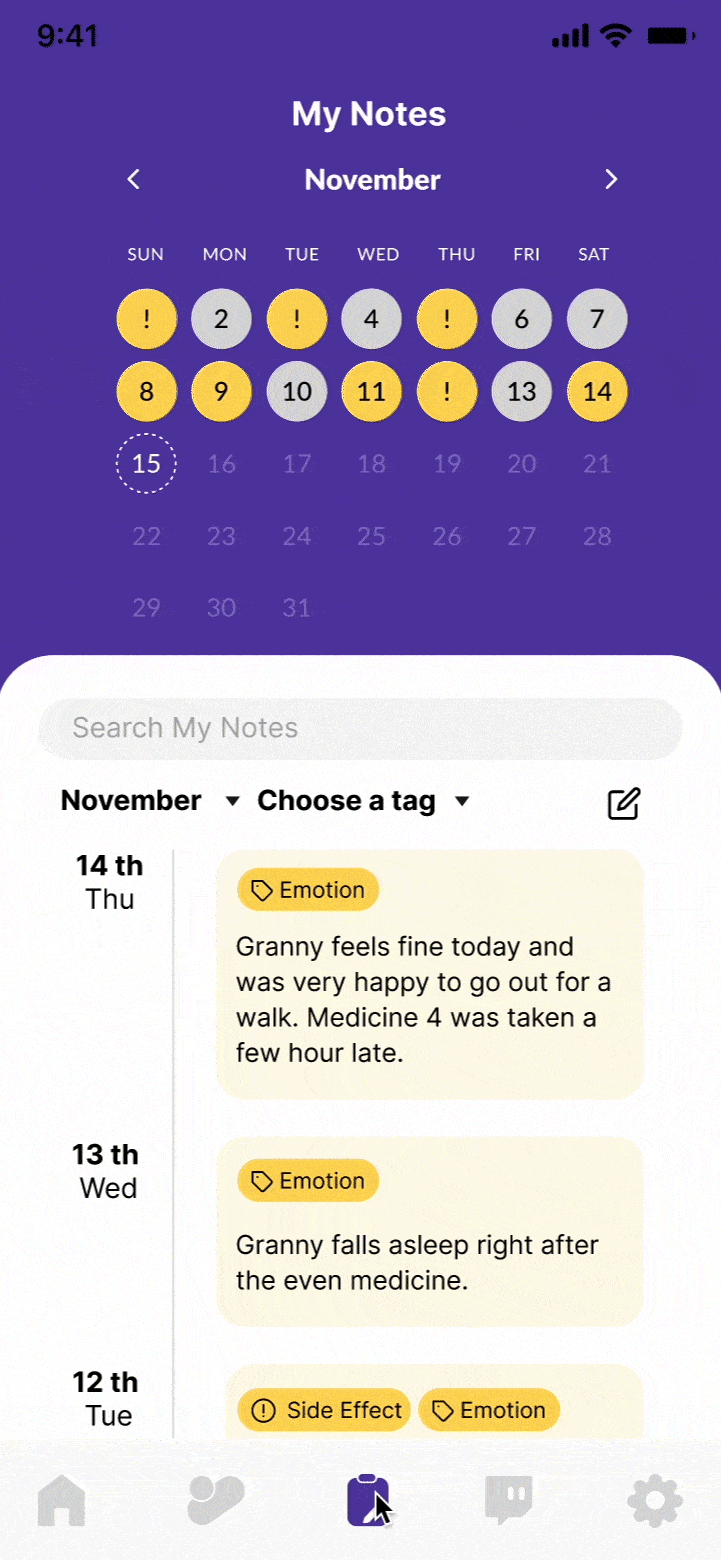
Scan and Check Medicine Distribution
By using the AI-powered scanning feature, users can ensure the correct medicine is distributed, even if they are not in their best condition.

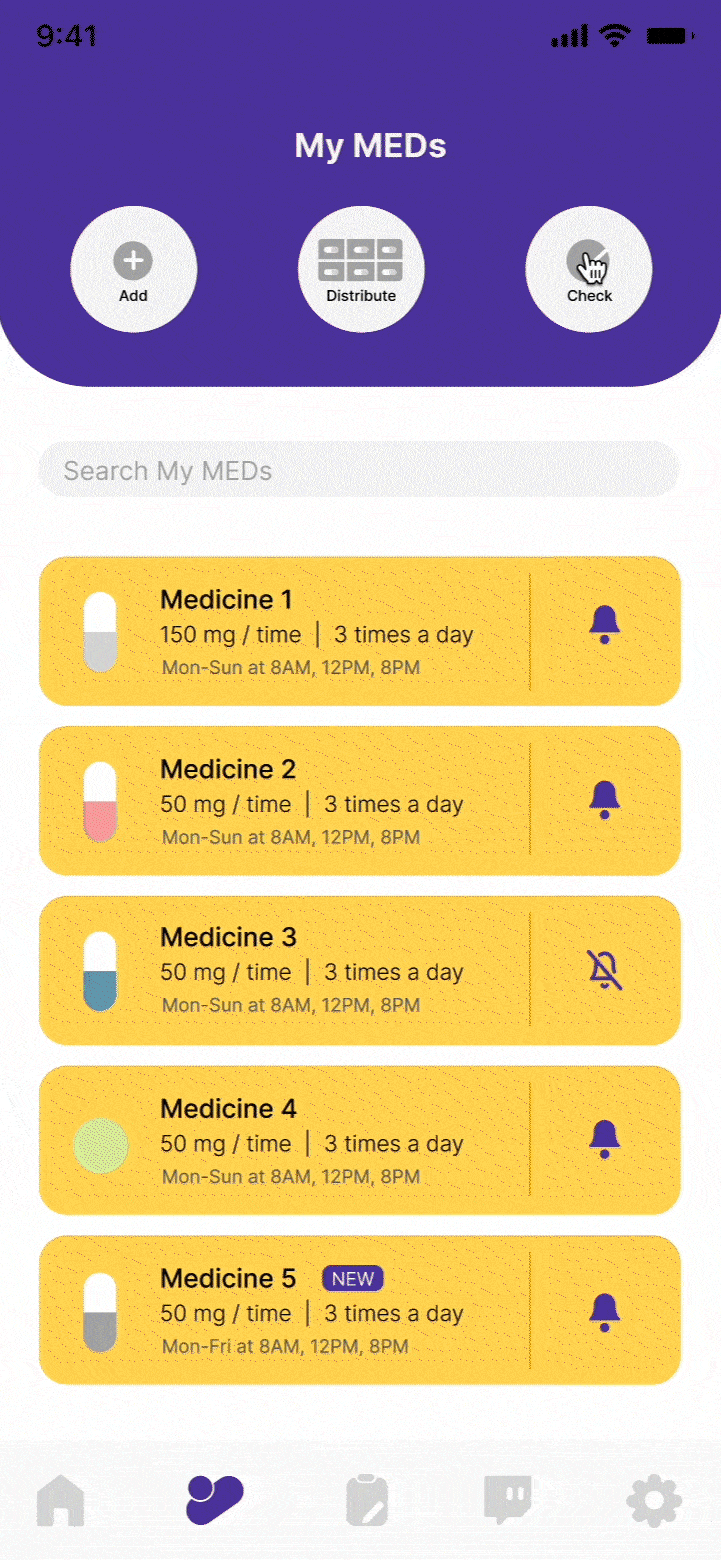
Pillbox Design
Our design rationale aims to prevent mistakes at every step of medical adherence. The solution integrates both software and hardware to address common issues in medical adherence. The software focuses on helping users avoid misreading medicine information, placing the wrong medicines in the pillbox, and miscommunication between caregivers. Meanwhile, the pillbox ensures users take the correct medicine by lighting up the corresponding compartment when it's time to take the medication. Once the pillbox detects the removal of the medicine, the system will automatically notify caregivers that the patient has taken their medication (based on user settings).
